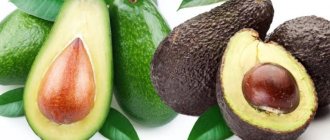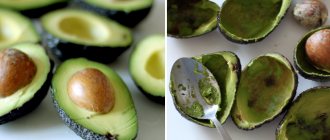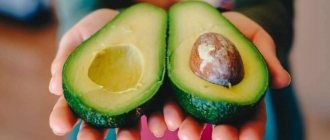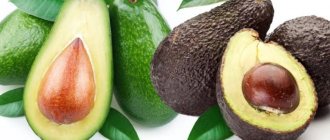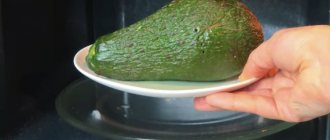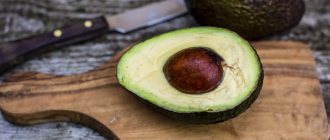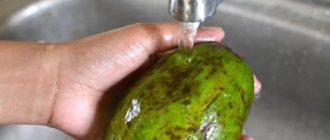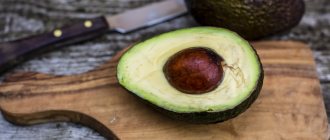Repost
There is a special pleasure when you cut into a perfect, ripe avocado, with its oily, pliable, but quite elastic flesh.
Rich in healthy fats and macronutrients, the avocado makes a delicious, energizing snack on its own and adds a wonderfully decadent, creamy flavor to dishes. But avocado is a very finicky fruit; its flesh quickly oxidizes and darkens when exposed to air. And if you only need a few slices of avocado for a salad, you are doomed to contemplate the sad fate of the remaining half of the fruit.
And although the best way to enjoy a ripe avocado is to eat it right away, there are still a few secrets to keeping your cut avocado fresh.
Don't throw away the bone
You may know that when you cut an avocado, you should use the pitted half first. Half with the pit can be stored in the refrigerator for 24 hours. Also, if you have leftover guacamole or have chopped but not used an avocado, place it and the pit in an airtight container and refrigerate. Airtight containers are better than plastic bags and film because, as the name suggests, they are airtight.
However, this method only works for short-term storage of avocados. The pit will keep the flesh underneath perfectly green since that area won't be exposed to air, but you'll still have to scrape off the brown stuff from the rest of the fruit.
Slice of lemon
Experience shows that citric acid helps preserve the color of avocados. If you want to keep a cut avocado fresh for just a few hours, say you're going to eat it for lunch at the office, place the avocado halves crosswise (just don't peel them), place a couple of lemon slices between them, squeeze tightly and wrap your “sandwich” in film.
Onion
This unexpected combination is the best way to keep avocados fresh for days. If you have leftover avocado pieces and won't be using them anytime soon, place them in an airtight container along with a large piece of onion and refrigerate. While it's not entirely clear why this odd couple works so well together, it's believed that it's due to the sulfur compounds released by onions. You don’t have to worry about the taste of avocado – it won’t change. You can also use this tip for storing guacamole.
1. Store with onions. A quarter of a freshly cut (important) onion, when placed in a plastic container with a lid with an avocado inside, will prevent the latter from darkening. The sulfur compounds released by onions are responsible for this - the same ones that often make you cry hot tears. The avocado and onion will last a couple of days together.
2. Grease with olive oil and immediately place in the refrigerator. It is necessary to lubricate generously. Essentially, you prevent air from reaching the surface and thereby prevent darkening.
3. Grease with lemon juice and also put in the refrigerator - this is if you don’t have olive oil on hand. Only if lemon is used, the avocado must also be tightly wrapped in plastic, otherwise the juice will quickly evaporate or drain.
Avocado is one of those versatile foods that can be used as an ingredient in a wide variety of dishes. However, as with other fruits, avocado tends to quickly “wither ,” that is, it quickly loses its freshness, becomes dark and, of course, no longer looks as attractive and appetizing as we would like.
Most people know that to get the most out of avocados, they are best eaten fresh and whole, and the rule of thumb is “the sooner the better.” But sometimes you can’t eat the whole avocado and you’re left with a piece that you’d hate to throw away and at the same time have nowhere to put it.
Fortunately for us, there are several ways that will allow you to keep this fruit fresh and green longer and use it for its intended purpose later.
Leave a pit
Our first tip to keep your avocado fresh longer is to leave the pit in it and don't throw it away. That is, use one half of the fruit and leave the other half along with the pit.
This is not the best way to preserve an avocado, since it only allows you to do it with one half of it (the one with the pit left).
If you have more left, the rest will quickly weather and darken. To prevent this, you can try to find something that will serve as a pit, but it is better to try to cover the entire remaining piece of avocado.
Onion
This method is as follows: you need to cut a quarter of the red onion into large pieces and place them on the bottom of an airtight container. Then you can put the half of an avocado that you have left unused there, so that the pit faces up. Close the container with a lid and place it in the refrigerator.
This tip is very effective, and the whole point is that the vapors that come from the onions allow you to preserve the natural green color and freshness of the avocado. In addition, the only part that comes into contact with the onion is the avocado peel, which means such storage will not affect its taste in any way. Yes, and chopped onions can also be used for other purposes.
Is it possible to eat avocado if it tastes bitter?
Unripe or overripe fruit usually tastes different. Overripe fruit compensates for the bitterness with an oily and soft texture.
An unripe avocado will be bitter inside to such an extent that it will simply be impossible to enjoy eating it. Bitterness does not mean that the fruit loses its beneficial properties or becomes harmful: it is just a sign of the level of ripeness and a characteristic of taste.
Lemon juice
Another way to preserve the freshness and color of an avocado is to use lemon juice. These two ingredients complement each other perfectly and are often used together in various recipes, and therefore, despite the fact that the avocado will become more acidic, this will not spoil it at all.
Citric acid significantly slows down the oxidation process and you will just need to pour lemon juice over the rest of the avocado.
The second option is to place a large slice (circle) of lemon on top of the remaining half of the avocado (without the pit). In both cases, it is best to store avocados in an airtight container at 4 ºC for no more than 2-4 days.
How can you preserve avocados for the winter?
How to freeze an avocado?
- Cut the avocado in half, remove the skin and bones. Brush the avocado halves with a little lemon juice and wrap tightly with plastic wrap. ...
- Place avocado halves in plastic freezer bags. ...
- Take it out when you're ready to use it, let it thaw and enjoy!
15 Mar
2022 Interesting materials:
How many threads do you need for Snood in two turns? How long should honey mushrooms be cooked? How many push-ups do you need to do on GTO? How much oatmeal do you need for a glass of milk? How much sand do you need per ton of cement? How long should you reheat frozen pizza in the microwave? How much protein should you eat? How much waste paper does it take to save one tree? How much salt do you need for herring? How much salt do you need to salt meat for drying?
Cling film
Food (polyethylene) film is also an indispensable tool for preserving the freshness of various food products and already prepared dishes. And avocado in this case will be no exception.
To do this, you just need to wrap the remaining piece of fruit in film and put it in the refrigerator. And if you notice that the avocado is still darkening (after a day or two), then it will be enough to simply remove the top weathered layer and you will again see the attractive green color of freshness.
If you hate throwing away the rest of the avocado and have nowhere to put it (everything is already cooked), then a great way to keep the fruit fresh is to make the famous and incredibly tasty guacamole from it. To do this, you just need to mash the avocado and add 1 tablespoon of lime (per half) to the resulting paste.
A tart lime juice (like lemon juice) will prevent the avocado from oxidizing and maintain its attractive green color. But to be sure, place your guacamole in an airtight container (you can also cover it with cling film first).
Thus, the film and lid will prevent the avocado from being exposed to oxygen, and hence its chapping and oxidation . Later you can use this avocado paste by adding it to a salad or just as is, it will also be very tasty.
Avocado fruits are a valuable source of protein for those following a vegetarian diet.
Some nutritionists even believe that avocado fruits can replace all other food for a person, and he can exist by eating only avocados and water. However, not every person knows how to eat avocado and what can be prepared from it.
How to peel an avocado?
To peel an avocado, you need to make a cut along the entire diameter with a sharp knife until the knife rests on the pit. Separate the two halves by twisting slightly (one clockwise and the other counterclockwise) - if the fruit is ripe, this should be very easy. Carefully walk the knife around the bone and remove it. Then you need to take half of the avocado and make another shallow cut in the skin from top to bottom. Gently pull the tip of the peel; it should peel off easily.
How to eat avocado?
The avocado fruit is eaten raw. Only the pulp of the fruit is consumed; the peel and pit are poisonous; they contain substances that can cause a dangerous allergic shock in humans.
It is easier and more convenient to eat it directly from the peel, using a spoon, sprinkling the fruit with lemon juice and seasoning with pepper and salt. When cooked, this fruit acquires a bitter taste and becomes unpalatable. You can make sandwiches from the avocado fruit, combining it with a slice of bread and a layer of fish, meat or crab sticks, and adding it to salads.
How to choose a good avocado?
To experience all the beauty of the described fruit, you need not only to know how to eat an avocado, but also how to choose it correctly.
Choose ripe fruits that are firm but not too hard. Press the peel with your finger; there should be an indentation. If the fruit is not ripe, it has a very unpleasant bitter-tart taste. Set aside those whose skin has any damage or defects and ignore the color. It can be different, because there are more than four hundred varieties of avocados in the world.
If you bought an unripe fruit, you can put it aside for a few days and it will “ripen.” The optimal temperature for long-term storage of avocados is ten degrees Celsius.
Growing an avocado from the seed?
Each fruit contains a large seed. It is not suitable for food, because... It is poisonous, but if desired, you can germinate it and plant it in the ground. If everything goes well, you will have an interesting indoor plant with a small number of leaves at the top, which, however, is very sensitive to dry air and replanting. Now plant the avocado pit with the blunt end in the ground and the sharp end should remain level with the soil. Before the leaves appear, grow the avocado at 18°C, and then transfer to a cool place.
What are black spots inside an avocado?
The appearance of black dots inside is associated with technical ripeness. Ripeness is determined by several criteria:
- the mark from light pressure quickly disappears, the shell takes its previous shape;
- the area where the cutting was located becomes green, with brown spots;
- when pressing on the handle, the oil accumulated inside may seep out;
- when shaking inside, you can hear the tapping of the bone;
- The bone is easily separated from the pulp: it can be removed with a spoon.
The appearance of the peel will not say anything about the ripeness or safety of the pulp inside. Depending on the variety, the peel has green, brown and intermediate colors.
Whether an avocado can be eaten can be determined by the color and structure of the pulp. If the pulp is covered with black dots inside, this may indicate a violation of storage rules. The appearance of black spots occurs due to the fact that the fruit was first stored in a cold room, and then it gets into the heat.
The answer to the question whether it is possible to eat pulp with black dots inside also depends on how much blackness is spread over the surface. If the black spot is located far from the seed and the area covered by it is approximately 10% of the total, then such fruit can be removed by first removing the black spots with a spoon. Small black dots are picked out with the sharp tip of a knife, and then the pieces of pulp are used for their intended purpose. Such pieces will not taste bitter or have any other unpleasant taste.
If the black spot completely surrounds the pit on both halves, and when removed it turns out to be widespread at all levels within the pulp, then the fruit should not be eaten. In this case, there are several reasons for the appearance of black spots:
- sudden change in climatic conditions during storage;
- long stay at low temperatures;
- violation of transportation methods;
- possible stay in water and subsequent drying.
A black spot is evidence of overripeness. With maximum spread, it threatens the fruit with loss of taste and beneficial properties. It is better not to eat such fruit, since, most likely, it will taste bitter and, in addition, will lose its beneficial properties.
Why do avocados turn dark?
Avocado flesh darkens when the fruit is cut because the enzymes in the flesh oxidize when exposed to air. This doesn't mean everything is ruined - you can just remove the top brown layer and everything will be a bunch.
That is, in other words, a blackened avocado can be eaten (if it is not spoiled, of course), it just may not look very aesthetically pleasing.
OK, let's figure out how to store avocados to preserve their freshness and appearance (if possible).
Overly soft with bruised skin
When checking for ripeness, use the palm of your hand to gently squeeze the avocado. Do not press the fruit with your fingers as this may damage the flesh.
If the avocado is very hard and cannot be pressed at all, it means it is unripe. If it gives a little, it's probably ripe and ready to eat.
However, if squeezing leaves small indentations, the fruit may be too ripe to cut and would benefit from being pureed.
The fruit is overripe and probably spoiled, perhaps if pressure leaves large dents and the fruit becomes soft.
Also, if the avocado already has dents before you squeeze it, it's probably already started to go bad (2).
If you gently squeeze an avocado in the palm of your hand and it forms large indentations where you pressed, the fruit is overripe and likely spoiled.
A couple of notes
1. When you defrost an avocado, it's best to do it slowly; you can simply move it from the freezer to the refrigerator. So, of course, the defrosting process will take longer than at room temperature, but the texture and color of the fruit will be better.
Alternatively, you can take out a bag (the one with a ziplock) and place it in a container of cold water - this is also a normal method.
2. Once frozen, the texture of the fruit will change, so it is best used for guacamole, or as a puree on bread and toast.
There is a special pleasure when you cut into a perfect, ripe avocado, with its oily, pliable, but quite elastic flesh. Rich in healthy fats and macronutrients, the avocado makes a delicious, energizing snack on its own and adds a wonderfully decadent, creamy flavor to dishes.
But avocado is a very finicky fruit; its flesh quickly oxidizes and darkens when exposed to air. And if you only need a few slices of avocado for a salad, you are doomed to contemplate the sad fate of the remaining half of the fruit.
And although the best way to enjoy a ripe avocado is to eat it right away, there are still a few secrets to keeping your cut avocado fresh.
Don't throw away the bone
You may know that when you cut an avocado, you should use the pitted half first. Half with the pit can be stored in the refrigerator for 24 hours. Also, if you have leftover guacamole or have chopped but not used an avocado, place it and the pit in an airtight container and refrigerate. Airtight containers are better than plastic bags and film because, as the name suggests, they are airtight.
However, this method only works for short-term storage of avocados. The pit will keep the flesh underneath perfectly green since that area won't be exposed to air, but you'll still have to scrape off the brown stuff from the rest of the fruit.
Slice of lemon
Experience shows that citric acid helps preserve the color of avocados. If you want to keep a cut avocado fresh for just a few hours, say you're going to eat it for lunch at the office, place the avocado halves crosswise (just don't peel them), place a couple of lemon slices between them, squeeze tightly and wrap your “sandwich” in film.
Onion
This unexpected combination is the best way to keep avocados fresh for days. If you have leftover avocado pieces and won't be using them anytime soon, place them in an airtight container along with a large piece of onion and refrigerate. While it's not entirely clear why this odd couple works so well together, it's believed that it's due to the sulfur compounds released by onions. You don’t have to worry about the taste of avocado – it won’t change. You can also use this tip for storing guacamole.
- Author: Maria Sukhorukikh
Rate this article:
- 5
- 4
- 3
- 2
- 1
(0 votes, average: 0 out of 5)
Share with your friends!
By taste or smell
Ripe avocados have a pleasant, slightly sweet aroma and a slightly nutty taste. As the fruit spoils, its taste and smell may deteriorate.
If it tastes or smells sour, it may have bacterial spoilage and should be discarded (2).
A chemical smell and taste may mean it is rancid. This can happen when oxygen or microbes damage or break down the unsaturated fat in the fetus (4).
Rancidity can lead to the formation of potentially toxic compounds. Don't eat an avocado if you think it's rancid (5).
The taste of spoiled avocados can vary, but it's usually easy to tell if they've gone bad based on the taste.
You can tell if an avocado has gone bad by smell, taste, touch, and visual inspection.
A sour taste or smell, as well as a rancid aroma and chemical taste mean the avocado is spoiled and you should discard it.

